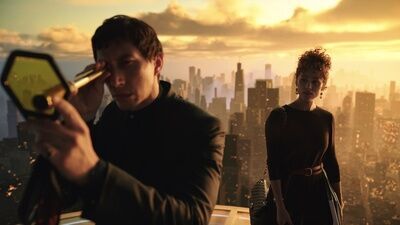
[ad_1]

After “Megalopolis,” I am at a loss as to what to do with Andrea Arnold’s “Bird,” whose central quirk is to start from her usual mode of kitchen-sink realism (“Fish Tank”) and then to add an element of the surreal—namely, a character named Bird (Franz Rogowski), a mysterious, ethereal, skirt-wearing man who is looking for his parents. At times he even perches himself atop a building as if he were a bird. That seemed pretty weird this afternoon, but then the Coppola happened.
Suffice it to say that “Bird” is a slow-burning, well-observed movie about a 12-year-old, Bailey (Nykiya Adams), whose father, Bug (Barry Keoghan), seems so young relative to her that it’s a shock when we first learn how they’re related. But becoming extremely young parents is normal at Tyler House, where Bailey, Bug, and Bailey’s half-brother Hunter live. Now Bug, finally transitioning into what he sees as a form of adulthood, is marrying, and Bailey fears that the fiancée and her child will freeload. Meanwhile, Bailey’s other half-siblings live elsewhere with her mother. “Bird” is an unusual portrait of broken families that somehow, to some degree, maintain something like a common nest.

Outside of the competition, the festival has found two of the world’s most adventurous nonfiction filmmakers turning to dramatization without quite leaving behind their old methods.
In the denatured Civil War picture “The Damned,” set in 1862, Roberto Minervini imagines what life would have been like for a party of Union soldiers assigned to patrol and protect uncharted borderlands in the west. (The film was shot in Montana.) The men, generally unnamed but recognizable by their attitudes and facial hair, are a mix of young and old, idealistic and embittered. Some are fighting for what they see as a divine cause, others for a paycheck. Sometimes the sound is mixed so that their voices aren’t privileged above the harsh environment.
Like Kelly Reichardt’s minimalist western “Meek’s Cutoff” (but even more minimalistically), “The Damned” focuses on the hard work and the solitude of traversing untamed territory. The solders hunt, handle wagon trouble, pitch tents, and examine rocks. A 16-year-old fighter learns how to cock a gun. When, after about a half an hour of screen time, an unseen enemy suddenly starts shooting, the violence is shown only as a barrage of gunfire sparks and bullet impacts. Those on the other side of the firefight are never glimpsed, but the implication is that they’ve been dealing with the elements—and the tedium—of the wilderness just like our men.
[ad_2]